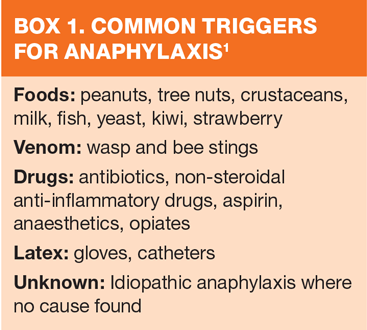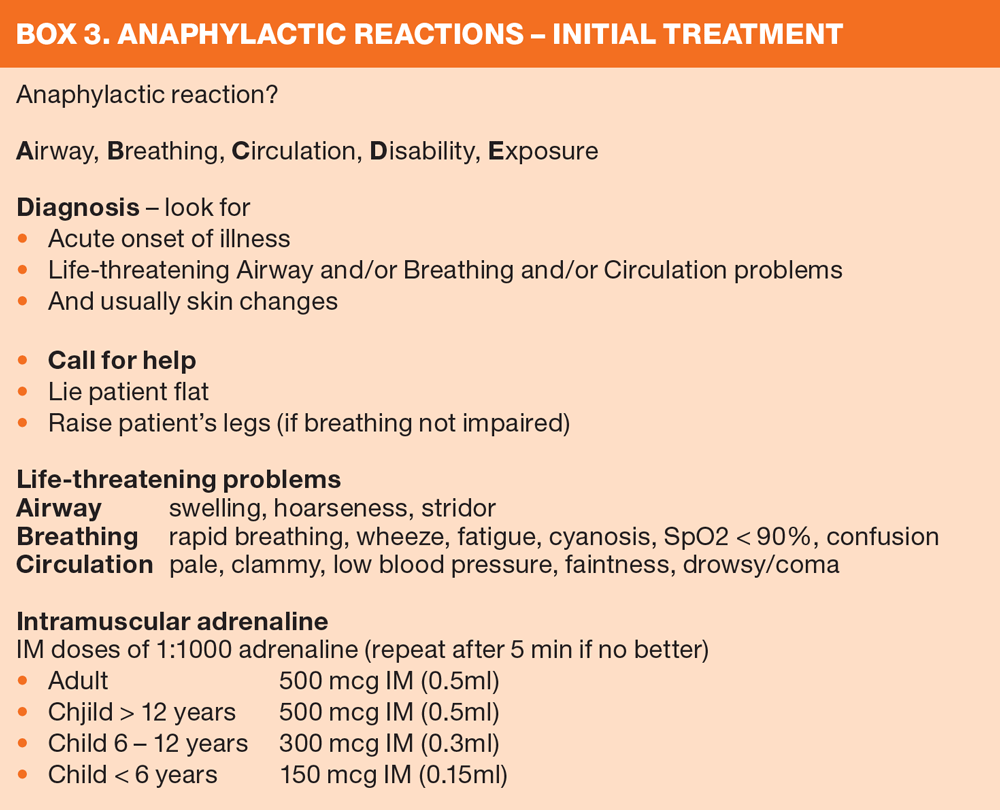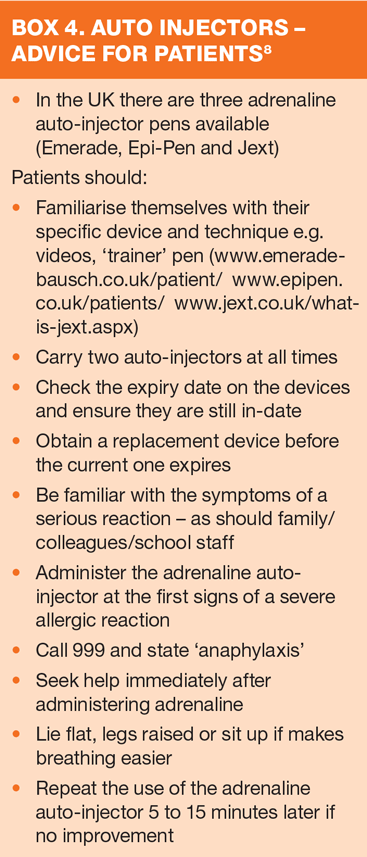
Anaphylaxis
Katherine Hunt
Katherine Hunt
RGN, RM, BSc (Hons) Non-medical independent prescriber NDFSRH
Practice Nurse, Framlingham Medical Practice, Suffolk
In the first of two articles on allergic reactions in this issue, we look in detail at what to do in the event of an anaphylactic reaction: this is something that all primary care staff need to keep themselves up-to-date on and this article aims to complement regular mandatory refreshers
It’s the usual Monday morning chaos – your clinic is fully booked and you are already running late. A call comes through from reception to say a gentleman has just arrived who has been stung by a wasp. The new receptionist makes the comment that his face looks a little puffy and he sounds rather wheezy. She asks, as you are busy, if she should get him to come back at the end of your morning clinic?
WHAT IS THE RISK?
Thankfully, anaphylaxis is a rare event. However, according to the Resuscitation Council it is on the increase, is often underestimated and not always recognised.1 NICE states that there are approximately 20 reported deaths in the UK per year from anaphylaxis with an estimate of approximately 1 in 1,333 of the population in England experiencing anaphylaxis at some point in their lives.2 Potentially life-threatening, general practice nurses need to be able to recognise and respond to anaphylaxis promptly. Treated correctly, the prognosis is good with less than 1% of reported cases fatal.1 In truth, many nurses may go through their whole careers without encountering a patient having an anaphylactic reaction. In the community, patients with anaphylaxis that has been triggered by food, insects or drugs are most likely to avoid primary care altogether and go straight to A&E. Rural practices, however, may be the first port of call for patients who live a considerable distance from the nearest hospital. Anaphylaxis resulting from immunisation, rare though it is, can occur and could happen in any primary care setting. Is it therefore vital that we maintain our knowledge, skills and competence in order to act swiftly, confidently and in line with the national guidance.
THE FACTS
Anaphylaxis is essentially a severe, unpredictable, and often rapid, hypersensitivity reaction. In many cases it is due to a known allergen. However, it is just as likely to occur in individuals who have no known risk factors. According to the Green Book,3 anaphylaxis is likely when the following three criteria are met:
- sudden onset and rapid progression of symptoms;
- life-threatening airway and/or breathing and/or circulation problems;
- skin and/or mucosal changes
The majority of anaphylaxis is caused by a severe allergic response to a trigger (Box 1). Figure 1 illustrates the process of sensitisation when the body is exposed to an allergen and its effect on the immune system. In children, food triggers are more likely to be the precipitating factor for anaphylaxis whereas in adults the cause is more commonly a severe adverse drug reaction (iatrogenic anaphylaxis) or the consequence of a wasp or bee sting. In some cases, despite thorough investigation, no cause is found (idiopathic anaphylaxis). Certain factors increase the risk of an individual experiencing a severe reaction.4 These include:
- Poorly controlled asthma
- Concurrent infection
- After or before heavy exercise
- After alcohol consumption
- During periods of emotional stress
- Concurrent aeroallergen symptoms such as rhinitis and asthma as a result of pollen, house dust mites, moulds and pets
ANAPHYLAXIS OR NOT?
Box 2 highlights the range of signs and symptoms of anaphylaxis. Although most cases have the familiar skin and mucosal changes these can be subtle and in fact absent in up to 20% of anaphylactic reactions.2,3 Equally, to complicate matters, the presentation of skin and mucosal signs alone are not proof of anaphylaxis. Confusion can also arise if the patient presents with a systemic allergic reaction such as angiodema, rhinitis or even urticaria but lacks the diagnostic symptoms of anaphylaxis of hypotension, urticaria rash, pallor and respiratory distress. We may all have had patients who have had panic attacks prior to immunisation, hyperventilating, covered in blotchy skin from anxiety and having a sense of ‘impending doom’.1 Those patients who faint straight after having their injections can be somewhat alarming but they are more likely to have a bradycardia with a vasovagal episode rather than the rapid pulse together with the urticaria, breathing difficulties and swelling, which accompany anaphylaxis. Then there are the breath-holders, sometimes seen when immunising children, who can get our own pulses racing especially if they momentarily lose consciousness. But breath-holding is not anaphylaxis. Even asthma attacks can be misdiagnosed as an anaphylactic reaction, equally triggered by an allergic response, but not sharing the definitive anaphylaxis symptoms.
BEST PRACTICE
Management of anaphylaxis is essentially treating the patient’s symptoms. The Resuscitation Council1 outlines the care patients presenting in anaphylaxis should receive as a minimum:
- Recognition that the patient is seriously unwell
- Instigate an early call for help – to colleagues and 999
- Initial assessment based on the ABCDE approach (Box 3)
- Adrenaline therapy, if indicated
- Investigation and follow up by an allergy specialist’
The aim is to keep the patient alive and to improve their clinical condition. If time allows, taking a full history of the proceeding events from the patient or their companion if present, together with an assessment of their clinical history. However, it is vital that treatment shouldn’t be delayed by a lack of complete history , will aid diagnosis. or a definite diagnosis.
Adrenaline
Adrenaline is the most effective drug to treat an anaphylactic reaction. It acts quickly, reverses peripheral vasodilation and reduces oedema. It dilates bronchial airways to benefit respiration and increases cardiac output improving blood pressure. In addition, it suppresses histamine and reduces the potency of IgE-mediated allergic reactions. Used appropriately it is a safe drug and the sooner it is given, the better the response. Box 3 highlights the dosage of adrenaline, which must be given intramuscularly, according to age.1 Needle length (a blue [25mm] needle is suitable for most patients) is important to ensure the adrenaline is injected into muscle, and the injection should be given at 90° angle to stretched, not bunched, skin.1 Intravenous adrenaline can be hazardous and used only in extreme emergency by appropriately trained staff. After administration of adrenaline, patients must be transferred to hospital due to the potential for delayed reactions. Patients taking beta blockers may have an intensified reaction to an otherwise mild allergic response due to the action of these drugs. Equally, such patients may have a delayed response to adrenaline, and in some individuals there is no improvement at all.1
A Patient Group Direction (PGD) is not required when adrenaline is required in a life-threatening emergency. Administering a specific dose of adrenaline under these circumstances is covered by the Medicines Act 1968 so that any nurse (and indeed parent and teacher) can give adrenaline without needing permission from a prescriber although some CCGs or Trusts may prefer to have a PGD as part of a framework for local practice.1
Additional care
Patients should be positioned so that they are comfortable and to reduce the risk clinical deterioration:
- Lie the patient flat and raise legs if breathing is not impaired
- If breathing is impaired, sit the patient up
- If unconscious, keep patient on their side to maintain their airway
- If pregnant, get the patient to lie on their left side to prevent caval compression
- If patient feels faint, they should not sit or stand due to increased risk of cardiac arrest
Oxygen should be given through a mask with an oxygen reservoir. If possible, the trigger for the anaphylactic reaction should be removed (e.g. bee stinger, stopping drug) but not at the expense of delaying treatment. Vomiting should not be induced if food is the cause of anaphylaxis. If things take a turn for the worse, and the patient goes into cardiorespiratory arrest, begin immediate cardiopulmonary resuscitation as per the Basic and Advanced Life Support guidelines.5–7
Immunisation and anaphylaxis
Practice nurses do countless vaccinations, from childhood immunisations, travel vaccinations through to shingles, pneumonia and influenza vaccines. Clearly an important part of pre-assessment is to establish whether the patient has had any confirmed anaphylactic reactions to previous vaccines or components of the vaccine. However, a lack of past history does not preclude a serious reaction occurring. Anaphylaxis occurring after immunisation is very rapid and usually happens within minutes of the vaccine being given but there is no specific national guidance on how long patients should be observed following immunisation.1,3
So how easy is it to access adrenaline in your surgery? Is it kept in a locked cupboard or held in another clinic room? If so, can you access emergency equipment fast or is there likely to be a delay whilst another patient is being attended to? Ideally, each room where vaccination is taking place should have a basic anaphylaxis kit, comprising of:
- 1ml graduated syringe x 4
- 23g blue needles x 4
- Adrenaline (Epinephrine) 1:1000 x 2
- One way pocket mask
- Dose chart
Clearly this needs to be up to date and accessible to all clinical staff who give vaccines. The use of antihistamines and steroids are not considered first line management.3 There is limited evidence to support the use of either drug although antihistamines may help with vasodilation and bronchospasm and steroids may possible shorten protracted reactions but management with these drugs must be undertaken by appropriately trained staff.
FOLLOW-UP
Referral to an allergy specialist for investigation and management is an important part of follow-up care. Determining the cause of the anaphylaxis through investigation is essential so the patient can learn to avoid the allergen, if detected, and manage the condition both through the recognition of symptoms and action to take in the event of a serious reaction. Immunotherapy, where the immune system is modified in order to prevent it reacting to an allergen, may be appropriate. When a drug is deemed to be the trigger the reaction, the Medicines and Healthcare products Regulatory Agency (MHRA) should be notified through the Yellow Card Scheme. In accordance with MHRA advice, patients with anaphylaxis are advised to carry two adrenaline auto injector pens (AAIs) and to be trained how and when to use them according to each specific device (see Box 4).8 However, recent guidance from the British Society for Allergy and Clinical Immunology (BSACI) suggests most patients only require one AAI although the advice has been disputed by the Anaphylaxis Campaign and Allergy UK.9,10 It is good practice to advise the wearing of medical alert jewellery and to inform family, colleagues, and school staff of the risk of anaphylaxis.
CONCLUSION
Thankfully, anaphylaxis is rare. We have a professional duty to maintain our skills, knowledge and competence to be able to act swiftly and confidently whatever its cause and however it presents. We also need to ensure colleagues are equally aware of how quickly to respond. So back to our new receptionist: when presented with the wheezy, puffy faced gentleman with a wasp sting, she should also know that it is imperative to deal with the situation with haste, alerting us immediately, however busy our day.
RESOURCES
Allergy UK http://www.allergyuk.org
Anaphylaxis Campaign http://www.anaphylaxis.org.uk
Anaphylaxis Campaign Fact Sheets http://www.anaphylaxis.org.uk/information-resources/patient-fact-sheets/
e-Learning for Healthcare: anaphylaxis http://www.e-lfh.org.uk/programmes/wm-anaphylaxis/
Emerade http://www.emerade-bausch.co.uk/hcp
Epipen http://www.epipen.co.uk/hcp/
Lifeline care and support (Jext) http://www.jext.co.uk
MHRA: Adrenaline auto-injectors: advice on use https://assets.publishing.service.gov.uk/media/54730805ed915d1380000045/con418524.pdf
NHS Choices: Anaphylaxis http://www.nhs.uk/Conditions/Anaphylaxis/Pages/Introduction.aspx
Resuscitation Council (UK) Anaphylaxis https://www.resus.org.uk/anaphylaxis/
Resuscitation Council (UK) Basic Life Support https://www.resus.org.uk/resuscitation-guidelines/adult-basic-life-support-and-automated-external-defibrillation/
REFERENCES
1. Resuscitation Council (UK). Emergency treatment of anaphylactic reactions. Guidelines for healthcare providers. January 2008. https://www.resus.org.uk/anaphylaxis/emergency-treatment-of-anaphylactic-reactions/
2. National Institute for Health and Care Excellence. Anaphylaxis: assessment and referral after emergency treatment. 14th December 2011. https://www.nice.org.uk/guidance/cg134
3. Public Health England. Immunisation against infectious disease. Vaccine safety and the management of adverse events following immunisation: the green book, chapter 8. March 2013. https://www.gov.uk/government/uploads/system/uploads/attachment_data/file/147868/Green-Book-Chapter-8-v4_0.pdf
4. Anaphylaxis Campaign. Anaphylaxis:the facts. October 2015. http://www.anaphylaxis.org.uk/wp-content/uploads/2015/06/Anaphylaxis-2015-version-8-with-links-in-full-1.pdf
5.Resuscitation Council (UK). Adult basic life support and automated external defibrillation. 2015. https://www.resus.org.uk/resuscitation-guidelines/adult-basic-life-support-and-automated-external-defibrillation/
6.Resuscitation Council (UK). Adult advanced life support. 2015. https://www.resus.org.uk/resuscitation-guidelines/adult-advanced-life-support/
7. Resuscitation Council (UK). Paediatric basic life support. 2015. https://www.resus.org.uk/resuscitation-guidelines/paediatric-basic-life-support/
8. Medicines and Healthcare products Regulatory Agency. Adrenaline auto-injector advice for patients. 2014.https://www.gov.uk/drug-safety-update/adrenaline-auto-injector-advice-for-patients
9. Ewan P, Brathwaite N, Leech S, et al. BSACI guideline: prescribing an adrenaline auto-injector. Clinical & Experimental Allergy. 2016; 46 (10): 1258-1280. http://onlinelibrary.wiley.com/doi/10.1111/cea.12788/full
10. Allergy UK. News Flash: BSACI Guidelines: prescribing an adrenaline autoinjector (AAI). https://www.allergyuk.org/blog/blog/post/263-
Related articles
View all Articles



